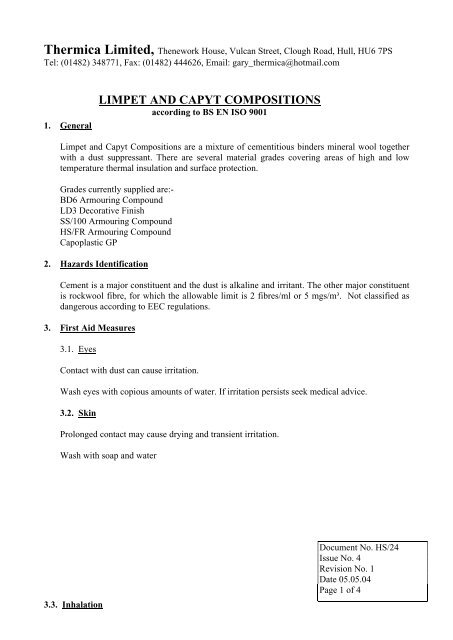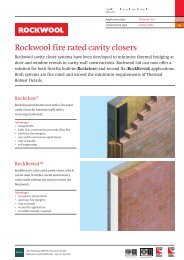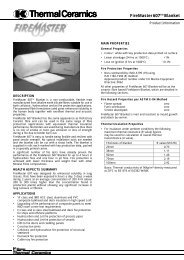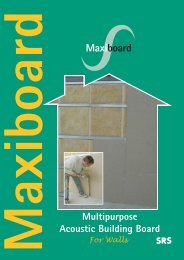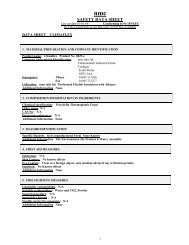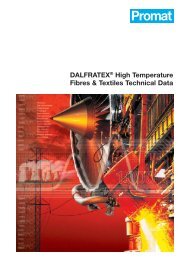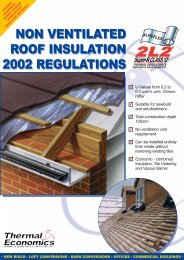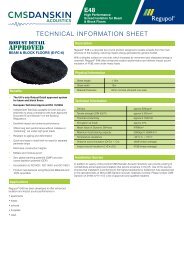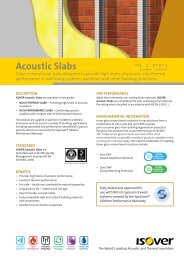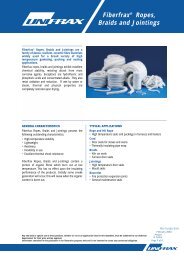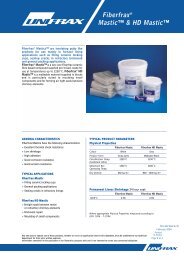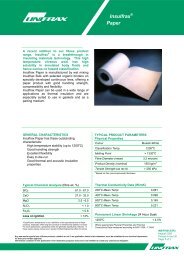BD6 Self Setting Cement.pdf - SIG Technical Insulation
BD6 Self Setting Cement.pdf - SIG Technical Insulation
BD6 Self Setting Cement.pdf - SIG Technical Insulation
Create successful ePaper yourself
Turn your PDF publications into a flip-book with our unique Google optimized e-Paper software.
Thermica Limited, Thenework House, Vulcan Street, Clough Road, Hull, HU6 7PSTel: (01482) 348771, Fax: (01482) 444626, Email: gary_thermica@hotmail.com1. GeneralLIMPET AND CAPYT COMPOSITIONSaccording to BS EN ISO 9001Limpet and Capyt Compositions are a mixture of cementitious binders mineral wool togetherwith a dust suppressant. There are several material grades covering areas of high and lowtemperature thermal insulation and surface protection.Grades currently supplied are:-<strong>BD6</strong> Armouring CompoundLD3 Decorative FinishSS/100 Armouring CompoundHS/FR Armouring CompoundCapoplastic GP2. Hazards Identification<strong>Cement</strong> is a major constituent and the dust is alkaline and irritant. The other major constituentis rockwool fibre, for which the allowable limit is 2 fibres/ml or 5 mgs/m³. Not classified asdangerous according to EEC regulations.3. First Aid Measures3.1. EyesContact with dust can cause irritation.Wash eyes with copious amounts of water. If irritation persists seek medical advice.3.2. SkinProlonged contact may cause drying and transient irritation.Wash with soap and water3.3. InhalationDocument No. HS/24Issue No. 4Revision No. 1Date 05.05.04Page 1 of 4
High exposure levels may cause coughing and mild respiratory tract irritation. If irritationpersists seek medical advice.The dust arising from these products is listed in Schedule 1 of the COSHH Regulations 1988,and in the H & SE Guidance Note EH46 (1990), and is subject to a maximum exposure limit of5 mgs per m³ and 2 fibres/m, which ever is achieved first (8 hour TWA total inhalable).Experience has shown that during operation the level of airborne dust and fibre could exceedthe MEL in the immediate vicinity of the application, It is therefore recommended that theoperatives use a disposable face mask bearing the 'CE' mark and conforming to BS/EN 149Type FFP2S.In very confined spaces the exposure levels may be above those for which a Type FFP2S maskis suitable, measurements may need to be carried out to determine the necessary level ofprotection required.Respiratory protection equipment should be used to provide a minimum nominal protectionfactor (NPF) of 10 (BS 4275), and to meet the requirements of BS2091 for half mask dustrespirators, and BS 6016 for disposable filtering mask respirators.3.4. IngestionNo known health effects. Drink plenty of water and seek medical advice.4. Fire Fighting MeasuresThe material are incombustible.5. Accidental Release MeasuresMinimise dust by damping with water.Dispose of in any land fill site in accordance with local regulations.6. Handling and StorageThe material will be damaged by moisture. It should be stored in the dry.7. Exposure Controls - Personal ProtectionProtect eyes from dust. Use gloves and overalls as normal protection against dusty materials.Use respiratory protection equipment as described in 3.3 above.8. Physical and Chemical PropertiesDocument No. HS/24Issue No. 4Revision No. 1Date 05.05.04Page 2 of 4
Thermica Limited, Thenework House, Vulcan Street, Clough Road, Hull, HU6 7PSTel: (01482) 348771, Fax: (01482) 444626, Email: gary_thermica@hotmail.comAppearance- Grey/white coloured mixture of fibres and powder.Odour- None.pH- Upto 14 when slurried with water.Melting Point - Around 1500ºC.Boiling Point }Flash Point }Flammability }Explosive properties } Not Relevant.Oxidising Properties }Vapour Pressure }Relative Density }Solubility }9. Stability and ReactivitySimilar to cement. The material is alkaline when slurried with water.10. ToxicologySubstantial independent research has been conducted into the health effects of mineral wooland humans. There is no evidence that mineral wool presents any risk to production workersor end users today, or has done in the past 20 to 30 years. In the general environment levels ofexposure are minute, and no hazard is posed to the public.The EU have classified most mineral wools as R38 Irritant to skin only providing that themanufacturers can supply a toxicological report which states that in a short-term biopersistencetest by inhalation that fibres longer than 20µm have a weighted half life less than 10 days. Thefibres used in this product comply with that standard. In situations where mineral wool isbeing handled, steps should be taken to ensure that exposure to dust is kept at a minimumreasonable level, and not in excess of control limits. As the products contain a high percentageof cement, and is therefore alkaline, suitable gloves should be worn whilst mixing or handlingthe materials.11. Ecological InformationThe addition of compositions to watercourses should be avoided as the resulting high alkalinitycould be hazardous to aquatic life.12. Disposal ConditionsSurplus material and empty bags should be disposed of as builder s waste.Document No. HS/24Issue No. 4Revision No. 1Date 05.05.04Page 3 of 413. Transport Information
No special requirements.14. Regulatory InformationH & SE Guidance Notes EH40, EH44 and EH46. Eurisol (UK Mineral Wool Association)Health Statement dated 1st November 1989 and 1st August 1990.15. Other InformationNone.16. DisclaimerThe statements in this Material Data sheet are offered in good faith as being accurate, but noguarantee of completeness can be made.It is the users obligation to evaluate this product safely, and to comply with all applicable lawsand regulations.No warranty is made either expressly or implied.KG/KLBDocument No. HS/24Issue No. 4Revision No. 1Date 05.05.04Page 4 of 4


